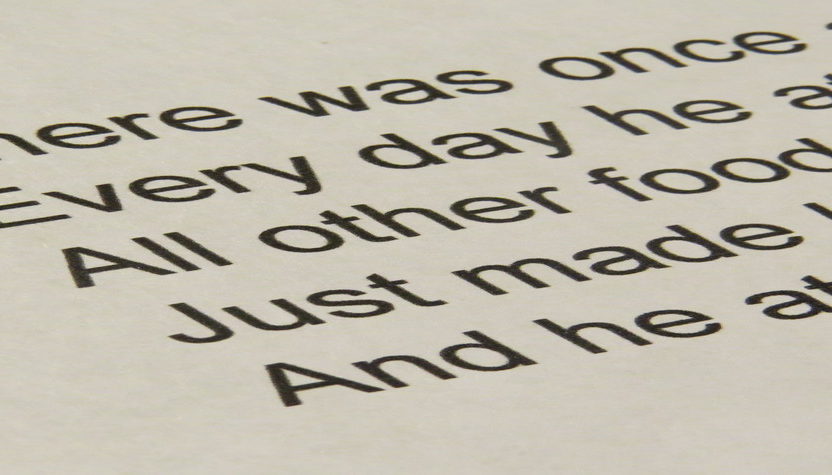Write Limericks around St. Patrick’s Day or any day! A Limerick is a 5 line poem with a rhyming pattern of AABBA. It’s typically a funny short story about a person in a specific place. In this post, I’m going to show you how to teach children to write their own limerick. Then, I’ll include 4 fun writing activitie and games to go along with the limericks. You can complete these 5 writing activities over the course of one week!
*This post contains affiliate links. For more information, see my disclosures here.*
The rhythm of the poem is usually:
1st Line: 9 syllables
2nd Line: 9 syllables
3rd Line: 6 syllables
4th Line: 6 syllables
5th Line: 9 syllables
Common Core State Standards
NOTE: This game can address the following Common Core Standards: CCSS.ELA-LITERACY.RF.RF.K.2.A, RF.K.2.B, RF.1.2, RF.1.3.E, RF.3.3.C and RF.4.3.A
Rhyme and Syllables
Because this poem incorporates both rhyme and syllables it takes the children more time to understand and complete. Be patient with them. Listen to their ideas and help them sort out their ideas so they fit the rhyming and syllable pattern.
Young or Struggling Writers
For younger or struggling writers I will actually write the words that we come up with together on a draft paper for them to copy onto a final paper.
Here are the steps!
Here’s how I guide the children in writing their own limericks!
- First, explain to the students the elements of a limerick (above).
Brainstorm
2. Second, brainstorm people: boy, girl, man, woman, prince, princess, king, queen, dentist, doctor, baker etc.
3. Third, brainstorm cities, states, countries, landmarks and general places that are easy to rhyme with:
New York
Singapore
France
Rome
Spain
Coast
Beach
Store
Mall
The Great Wall
Show the Layout
4. Next, show the layout of the poem:
LINE 1: There was once a ___(person)__ from ____(place)_____. 9 syllables
LINE 2: Who _______(action)___________________________. 9 syllables
LINE 3: When ________________________________________. 6 syllables
LINE 4: He/she _______________________________________. 6 syllables
LINE 5: ____________(how the story ended)________________. 9 syllables
- Point out that the last words on line 1, 2 and 5 should rhyme.
NOW TO WRITE!
- Choose a person and place.
- Write a long list of words that rhyme with the place.
- Think of a short silly happening or action that can fill line 2.
- Next, think of a silly problem to continue the story and to fill lines 3 and 4.
- Find a couple of words from your idea that are easy to rhyme with.
- Write a long list of words that rhyme with those words.
- Brainstorm ways to fill lines 3 and 4 so that they rhyme and have 6 syllables each.
- Think about how you can finish the short story using 9 syllables and rhyming with lines 1 and 2.
- Then, write your draft on scrap paper. Work with the poem until you like it and it follows the rhyme and syllable patterns.
- Lastly, write your final draft on paper with a border so it looks nicer.
Print the Lesson
Here’s the full lesson for you to print out and use.
EASY ART ACCENTS
As soon as the students finish their limerick they can fill their border with a St. Patrick’s Day art accent.
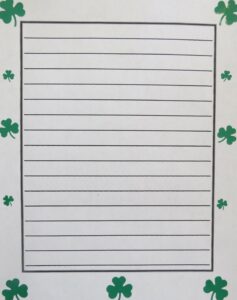
More Limericks to Read
Find funny limericks to share with your students here!
GAMES TO PLAY!
Here are 4 writing activities and games that you can play after writing limericks.
1. A-Z Places
Writing A-Z-word lists is a great activity to stretch brains and build vocabulary!
Here are the steps!
- Write the letters A-Z vertically in 4-5 columns on a classroom white board.
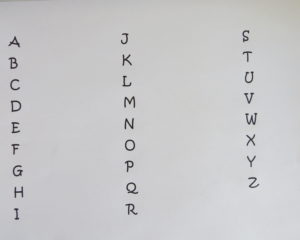
2. Second, explain to the children that they have to write a place for each letter of the alphabet. Fill in 2-3 letters with examples to get them started.
3. Third, have 2-3 children come up at a time to write in a word. Continue until there is a place for each letter of the alphabet. It gets challenging. But the kids can do it! And towards the end, if there are any letters without a word, you can use this list of A to Z Places to help you out!
Here is an activity sheet of the same activity that you can give to an individual student:
2. Syllables in Words
These next two games focus on syllables. You can play these two games before or after writing your Limericks. Additionally, they go really well with Haiku poems and poems that rhyme and require a certain number of syllables for each line. In short, these two games focus on counting syllables. Both games are excellent for helping children solidify their ability to hear and count syllables in words, phrases and sentences.
SYLLABLES IN WORDS
The first games is focuses on words.
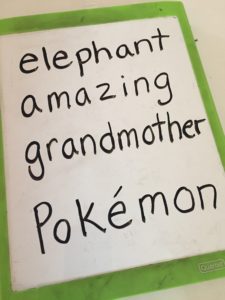
Common Core State Standards
NOTE: This game can address the following Common Core Standards: CCSS.ELA-LITERACY.RF.K.2, RF.K.2.B, RF.1.2, RF.1.3.E, RF.3.3.C and RF.4.3.A
One Magnetic Spinner
In order to play this game, you need one magnetic spinner*. If you haven’t read my full post on the winner spinner you won’t want to miss it! It gives you a long list of game ideas that are so easy to run and super fun for the kids. Check out the full post here.
NOW TO PLAY!
First, start off by drawing one circle on the whiteboard. Divide it into 4 sections and write the numbers 1, 2, 3 and 4.

Next, for smaller groups (up to 8) I divide the large whiteboard into 4 sections. A pair is assigned to each section.

Larger Groups
For larger groups, (or if I don’t have a large whiteboard or chalkboard), I divide the group into pairs. I give each pair a small white board, dry erase marker and a sock to serve as an eraser. You can purchase a class pack on Amazon*.



Now to Play!
- First, one child spins a number. Set a phone or timer to 1 minute.
- Second one partner from each pair takes a turn listing as many words as he or she can that have that number of syllables. For example, if a child spins a 3 their list might look like this:

3. Third, the students have 60 seconds to complete their list. Once they’ve completed their list, they don’t say anything. They just hold up their white board.

4. Fourth, check to make sure each word indeed has the number of syllables spun.
If you see one word that does not have the correct number of syllables, hold up one finger, two words, two fingers, three words, three fingers, four words, four fingers. If all the words fit, give a thumbs up so that the child can put a tally on his/her board for each word that he/she has written correctly.
5. Laslty, continue play until everyone has had a turn to spin or your allotted time runs out!
Print the Instructions
Here are the instructions for you to print out and use.
3. Syllables in Phrases
The second game focuses on syllables in phrases. Again, it also goes really well with Limericks, Haiku poems or a rhyme that requires a certain number of syllables for each line.
Common Core State Standards
NOTE: This game can address the following Common Core Standards: CCSS.ELA-LITERACY.RF.K.2, RF.K.2.B, RF.1.2, RF1.3.E, RF.3.3.C and RF.4.3.A
The Magnetic Spinner
Again, you need one magnetic spinner*.
Setting up the game:
First, start off by drawing one circle on the whiteboard. Divide the circle into 4 or 8 sections. Write the numbers 5-8 or 4-11.


Next, for smaller groups (up to 8) I divide the large whiteboard into 4 sections. A pair is assigned to each section.

Or, for larger groups, (or if I don’t have a large whiteboard or chalkboard), I divide the group into pairs. I give each pair a small white board, dry erase marker and a sock to serve as an eraser. You can purchase a class pack on Amazon*.



Now to play!
- First, one child spins a number.
- Second, one partner in each pair takes a turn writing a phrase that has that number of syllables. For example, if a child spins a 5, their phrase might look like this:

3. Third, once the students have completed a phrase, they don’t say anything. Instead, they just hold up their whiteboards.

4. Fouth, check to make sure each phrase indeed has the number of syllables spun. If a phrase doesn’t, shake your head “no” and smile. The student continues to correct the phrase. When the phrases fits, give a thumbs up and the child puts a tally on his or her board. Students who finish their phrase quickly can write more phrases, earning more points until each pair has completed at least one phrase.
5. Lastly, continue play until everyone has had a turn to spin or your allotted time runs out!
Print the Instructions
Here are the instructions for you to print out and use.


Again, we played these two games after writing Limericks. You can also play them after writing Haiku Poems.
4. Fill in the blank-Rhyme
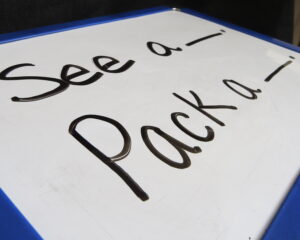
Fill in the Blank Rhyme is fast and fun!
Common Core State Standards
NOTE: This game can address the following Common Core Standard: CCSS.ELA-LITERACY.RF.K.2.A
First, divide the group of children into two groups, a left side and a right side. Second, one child from each group stands up. You begin a phrase from this list.

Third, two children race to fill in the blank with a word that rhymes with the phrase!

Fourth, those two students sit while the next two stand. This game is meant to move quickly and often gets fun and silly!
For example, “Shout a ____” may stump the children so they’ll shout out made up words (that indeed rhyme). You can accept these made up words, or wait for them to come up with something that is real such as “Shout a pout,” which itself is funny.
You don’t need to go through the entire list. Play according to the time you have. There are no points, no wins. Just fun!
Print the Instructions
Here are the instructions for you to print out and use.
Writing Prompts
We’ve played this game after writing the following prompts:
Calendar Page-Rhyming Couplets and Quatrains




We also play the regular Fill in the Blank game (without rhyme) following various writing prompts. This version can go along with ANY guided writing lesson really. It’s just a fast, short, sweet, fun game to play anytime!
